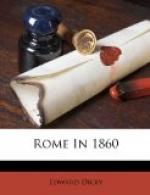crowd in order; but, unfortunately, there was no crowd
to keep in order; so that the soldiers looked and
seemed to feel as if they were sent on a fool’s
errand. At St Agnese there were some 150 carriages
collected, almost all hired ones, of the poorer sort.
The private vehicles were very few indeed; not a
quarter of the muster at most. The church itself
was gaily filled, but not crowded in any part.
Priests, monks, and women formed nine-tenths of the
congregation. The sacrament was administered
by the Pope himself to a number of communicants, amongst
whom the English converts visiting Rome were as usual
conspicuous. After mass was over the Pope had
breakfast at the Convent, and returned about noon to
the city. Meanwhile, something approaching to
a crowd, that is about 600 people, half of whom were
priests and the rest impiegati, were collected
at the gates; and as the Pope passed to his coach and
four, each of this crowd, with somewhat suspicious
unanimity, drew a handkerchief from his pocket, and
raised a feeble cheer. Inside the gates, and
along the streets through which the Papal procession
passed, there was no appearance of any unusual concourse
of people. By the corner of the Gualtro Fontane
street, near the new palace of Queen Christina, a
large body of nuns and school-children, decked out
in white, were drawn up on the pavement, who waved
their hats, and threw flowers as the Pope went by;
but this was all; and even the Pope himself could
hardly have supposed what demonstration there was to
be spontaneous. It is true the Giornale
made the most of it. Their narrative ran thus:
“About half-past eleven in the morning his Holiness,
accompanied by the applause of all who had joined
to escort him, entered his carriage, and took the
road towards his residence at the Vatican. Words
are insufficient to express the enthusiastic affection,
the joyous demonstrations, which, for the length of
three miles from St Agnese to the Quirinal, were manifested
towards him by the good people of this Sovereign City,
who had crowded to behold his passage; and who, by
any means in their power, expressed the tender affection
which they could not but entertain for his sacred
person. Infinite, too, was the number of carriages
which followed the Royal cortege to the Pontifical
palace of St Peter’s.”
To this I can only say, that many things are visible to the eye of faith, and hidden to the common world. To my unenlightened vision, the crowd of three miles in length was composed of a thousand persons in all; and the infinite number of carriages looked uncommonly like sixty.
And now for the converse picture.
The “Promised Land.”




